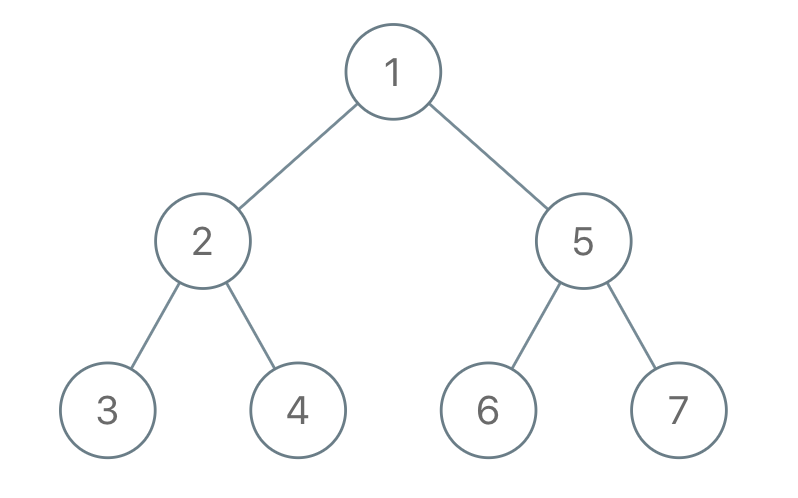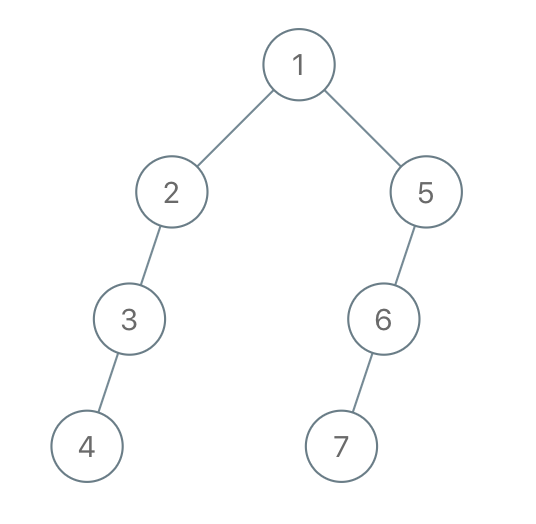rootof a binary tree. At each node in this traversal, we output D dashes (where D is the depth of this node), then we output the value of this node. (If the depth of a node is D, the depth of its immediate child is D+1. The depth of the root node is 0.)
If a node has only one child, that child is guaranteed to be the left child.
Given the output S of this traversal, recover the tree and return its root.
Example 1:

Input: "1-2--3--4-5--6--7"Output: [1,2,5,3,4,6,7]
Example 2:

Input: "1-2--3---4-5--6---7"Output: [1,2,5,3,null,6,null,4,null,7]
Example 3:

Input: "1-401--349---90--88"Output: [1,401,null,349,88,90]
Note:
- The number of nodes in the original tree is between
1and1000. - Each node will have a value between
1and10^9.
遍历输入字符串,先提取短杠的个数,因为除了根结点之外,所有的深度值都是在结点值前面的,所有用一个 for 循环先提取出短杠的个数 level,然后提取结点值,也是用一个 for 循环,因为结点值可能是个多位数,有了结点值之后我们就可以新建一个结点了。下一步就比较 tricky 了,因为先序遍历跟 DFS 搜索一样有一个回到先前位置的过程,比如例子1中,当我们遍历到结点5的时候,此时是从叶结点4回到了根结点的右子结点5,现在栈中有4个结点,而当前深度为1的结点5是要连到根结点的,所以栈中的无关结点就要移除,需要把结点 2,3,4 都移除,就用一个 while 循环,假如栈中元素个数大于当前的深度 level,就移除栈顶元素。那么此时栈中就只剩根结点了,就可以连接了。此时我们的连接策略是,假如栈顶元素的左子结点为空,则连在左子结点上,否则连在右子结点上,因为题目中说了,假如只有一个子结点,一定是左子结点。然后再把当前结点压入栈即可,字符串遍历结束后,栈中只会留有一个结点(题目中限定了树不为空),就是根结点,直接返回即可,参见代码如下:
解法一:class Solution {public: TreeNode* recoverFromPreorder(string S) { vector st; int i = 0, level = 0, val = 0, n = S.size(); while (i < n) { for (level = 0; i < n && S[i] == '-'; ++i) { ++level; } for (val = 0; i < n && S[i] != '-'; ++i) { val = 10 * val + (S[i] - '0'); } TreeNode *node = new TreeNode(val); while (st.size() > level) st.pop_back(); if (!st.empty()) { if (!st.back()->left) st.back()->left = node; else st.back()->right = node; } st.push_back(node); } return st[0]; }}; 虽然博主最开始想的递归方法不太容易实现,但其实这道题也是可以用递归来做的,这里我们需要一个全局变量 cur,表示当前遍历字符串S的位置,递归函数还要传递个当前的深度 level。在递归函数中,首先还是要提取短杠的个数,但是这里有个很 tricky 的地方,我们在统计短杠个数的时候,不能更新 cur,因为 cur 是个全局变量,当统计出来的短杠个数跟当前的深度不相同,就不能再继续处理了,如果此时更新了 cur,而没有正确的复原的话,就会出错。博主成功入坑,检查了好久才找出原因。当短杠个数跟当前深度相同时,我们继续提取出结点值,然后新建出结点,对下一层分别调用递归函数赋给新建结点的左右子结点,最后返回该新建结点即可,参见代码如下: 解法二: class Solution {public: TreeNode* recoverFromPreorder(string S) { int cur = 0; return helper(S, cur, 0); } TreeNode* helper(string& S, int& cur, int level) { int cnt = 0, n = S.size(), val = 0; while (cur + cnt < n && S[cur + cnt] == '-') ++cnt; if (cnt != level) return nullptr; cur += cnt; for (; cur < n && S[cur] != '-'; ++cur) { val = 10 * val + (S[cur] - '0'); } TreeNode *node = new TreeNode(val); node->left = helper(S, cur, level + 1); node->right = helper(S, cur, level + 1); return node; }}; Github 同步地址: 类似题目: 参考资料: